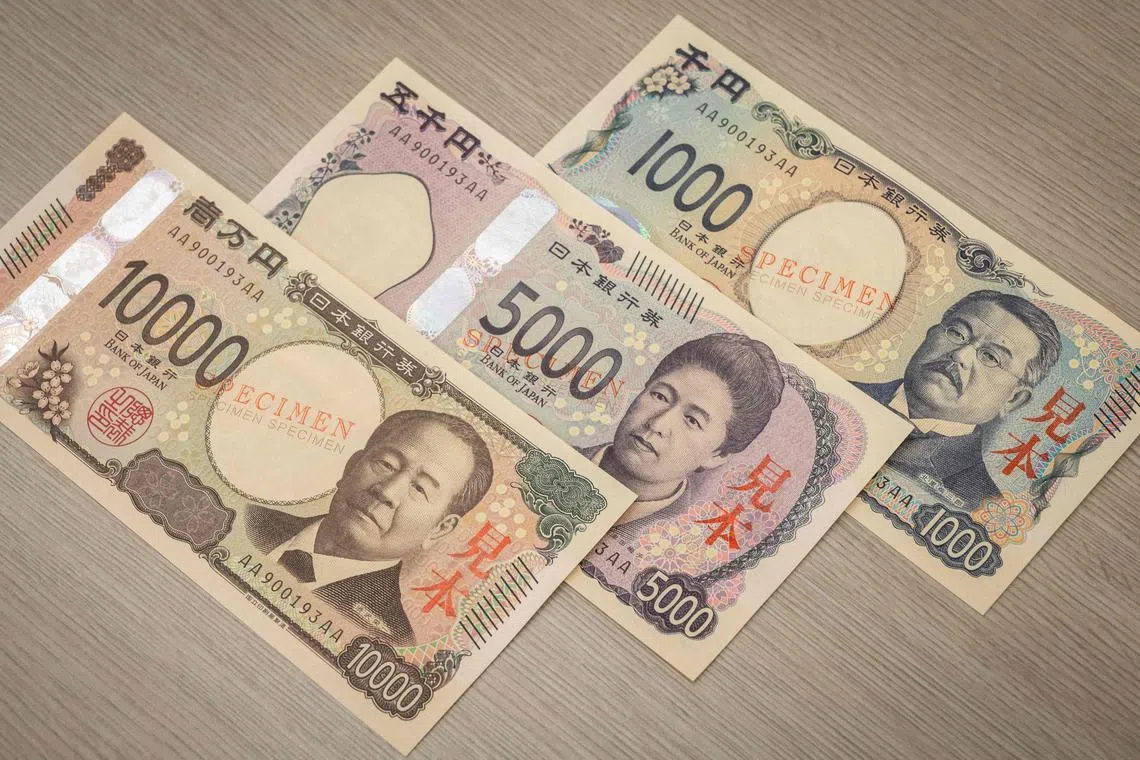Weak Japanese yen now the key to stronger currency and BOJ pivot later
Sign up now: Get ST's newsletters delivered to your inbox

The yen is at an almost eight-month low against the dollar and at its weakest against the euro in 15 years.
PHOTO: AFP
Follow topic:
TOKYO – Japanese policymakers and business leaders appear far more sanguine about the recent slide in the yen than they were about 2022’s intervention-triggering collapse – a sign that they see the weakness as temporary.
While the currency is at an almost eight-month low against the US dollar and at its weakest against the euro in 15 years, the panic of 2022 does not appear to be coursing through the veins of officials, consumers and company executives yet.
In 2022, Japan spent US$65 billion (S$87.7 billion) on direct purchases of the yen to help drag it off a three-decade low versus the greenback.
One key factor is the perception that central banks are nearer the end of the global rate hike cycle than the beginning.
While it is still not clear when those like the United States Federal Reserve will reach stop, that view has helped dampen fears that Japan is peering into the abyss of a yen free fall.
And an extended period of modest currency weakness could counter-intuitively lay the ground for long-run yen strength should it help the Bank of Japan (BOJ) boost growth, attain its inflation goal and finally embark on a pivot from the past decade of super easy monetary policy.
The bottom line boost to exporters from the soft yen and renewed optimism over the economy have already helped the stock market chalk up 33-year highs.
“Pressure on the yen won’t escalate much from here. The Fed is approaching its terminal rate with probably one more hike, at most two,” said Itochu Research Institute chief economist Atsushi Takeda. “The yen doesn’t have the same falling momentum like last year.”
Yen backdrop
The stark contrast between Japan and its ultra-low interest rates aimed at stoking prices and the robust rate hikes of the US intended to cool them has provided the key backdrop for yen weakness since the Fed began its tightening campaign in early 2022.
The Asian nation’s widening trade deficit as commodity prices climbed only added fuel to that fire.
The occasional brakes to that trend have been recession fears, banking sector turmoil and the realisation that Tokyo will act to defend its currency, even if it means irritating its allies in Washington.
Japan has a long-stated focus on the pace of declines rather than any particular target.
When officials stepped into markets as the currency approached 146 in September and 152 in October, on each occasion the US dollar had moved by more than 2 yen in less than 24 hours.
Volatility is at much lower levels in 2023.
“Although the yen has weakened, the issue here is the speed of moves and pace of inflation,” said Mitsubishi UFJ Kokusai Asset Management chief fund manager Kiyoshi Ishigane. “The authorities are unlikely to take action at this moment.”
But while the yen at 144 per dollar now seems a lot less scary than it did a year ago, a further fall towards the 150s would still likely jolt Japan out of its new comfort zone and on the road to fresh action.
Those levels would also be a bad place for Prime Minister Fumio Kishida to consider holding an early election
A decision by the US Treasury in mid-June to drop Japan from its currency watchlist appears to give a tacit green light to more yen buying by Tokyo should sharp moves justify it.
“They are only going to step in if the yen is about to break through 150,” said Dai-Ichi Life Research Institute executive economist Hideo Kumano. “Although they did it last year, currency intervention is still the last option.”
Yen beneficiaries
For now, policymakers are feeling less heat from the public and corporate realms.
While the plunging yen in 2022 may have forced some companies to tear up their hedging strategies, the current range is familiar territory.
Japanese companies with a global presence have long been the biggest beneficiaries of a cheap yen – a factor that inflates their overseas earnings.
A softer currency added 1.3 trillion yen (S$12.3 billion) to Toyota’s annual operating profits and magnified the sales of five key segments at Sony by about 1.2 trillion yen.
On the flipside, importers like Tokyo Gas feel the pain.
Its operating profit fell 9.5 billion yen due to the weaker currency in the latest fiscal year.
The difference in 2023 is that globally focused companies benefiting from the soft yen are now joined by a domestic travel industry revelling in the return of foreign tourists after the lifting of Covid-19 pandemic restrictions.
First-quarter spending by overseas visitors in Japan was around 88 per cent of what it was in 2019, with the biggest spenders coming from South Korea, Taiwan and Hong Kong.
That helped lift economic growth by an annualised 1.1 percentage point in the first three months of 2023.
“Unlike last year, the yen is now providing benefits to regional economies through a surge in foreign tourists,” said Itochu’s Mr Takeda. “That’s one of the key reasons that criticism hasn’t penetrated across the nation in the same way, providing the authorities with more time to monitor the situation.”
Cycle finale
Even without a move by the central bank to normalise its policy, analysts see the yen regaining some strength as the finale of the global tightening cycle plays out.
Expected rate increases by major central banks over the next 12 months are well below levels seen during intervention in 2022.
“It will probably be clearer in September when the Fed will stop tightening and there may be some signs from the ECB too,” said Market Risk Advisory fellow Koji Fukaya. “That means the yen may strengthen towards 130 before the year end and then 125 next year.” BLOOMBERG

